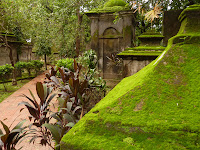
Walking around the Marble Palace is the closest I have come to a waking dream: I saw no other tourist until I was leaving; the lights in all the rooms were switched off until my guide switched them on, but even that did little to change how dimly visible many of the paintings (in particular, the ones mounted high up on the walls) were; and I kept stumbling across treasures – a Joshua Reynolds painting of the infant Hercules strangling serpents registered more of an impact than it ever could have in a well-lit museum gallery, a Murillo painting of St. Sebastian was perfectly placed to catch the light, and seemed better than everything else in the gallery (as did an amazing Jan Fyt still life at the foot of the staircase on the floor below, this one aided by the darkness), and Rubens’ Marriage of St. Catherine was on a wall so bereft of light it seemed older than it was, and bore only a distant kinship to other paintings that I had seen by the same artist; everything seemed charged with an obscure meaning, and it was hard to imagine these rooms as once inhabited. As with dreams, there was plenty of frustration to go around -- the guide knew little, and I never did find the Titian painting I knew was there somewhere – but that was part of the disorienting spell. Magic is difficult to find for the contemporary tourist, but last Saturday, for an hour or two in the early afternoon, the world slept at 46, Muktaram Babu Street in Calcutta. And dreamed.

I was right to realize that my feeling was completely unfounded: the colonial world is not past, it lingers. And that world is our world too, even as it renders us strangers to ourselves: the Marble Palace was built not by the British but by one of the wealthiest of the nineteenth century Company babus; eyes with a keener appreciation of architecture than mine can easily look past the European sculptures, exterior, and columns to spot the interior courtyard that the Palace shares with traditional Indian mansions. I needn’t have even wondered about those exotic Australian birds in the cages lining the walls and overlooking the courtyard, oddly unsettled as I was by this sign of life (even if imprisoned and foreign) that had appeared without explanation. On the upper floor, as I was leaving one of the galleries, I saw in front of me my guide bring his hands together in respect. I saw an old man on the other side, in a shirt and lungi, nodding to my guide; he neither looked at me nor acknowledged my presence in any other way. That’s Mallik sahib, my guide (whose accent placed him as being from Bihar or Eastern U.P.) told me. Half the Palace is off-limits to the public, because Rajendra Mallik’s descendants still live there, apparently the seventh successive generation to do so. I presume the birds belong to them.


1 comment:
Very romantic, poetic, sensitive description
Post a Comment